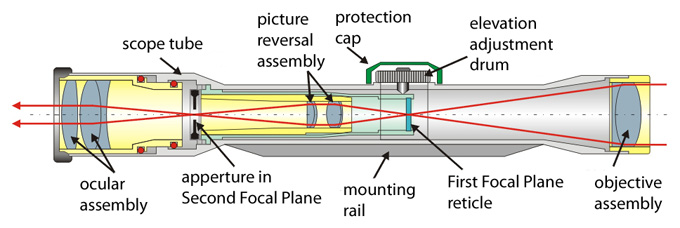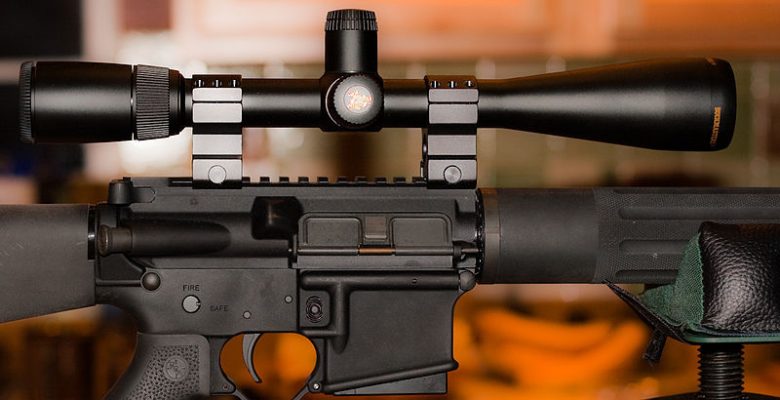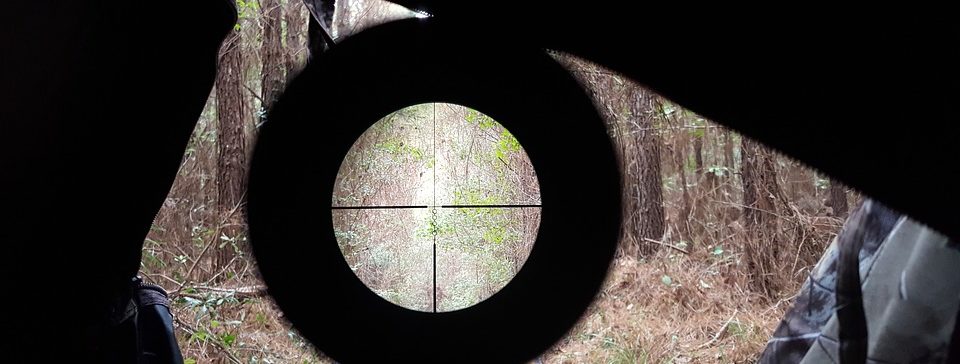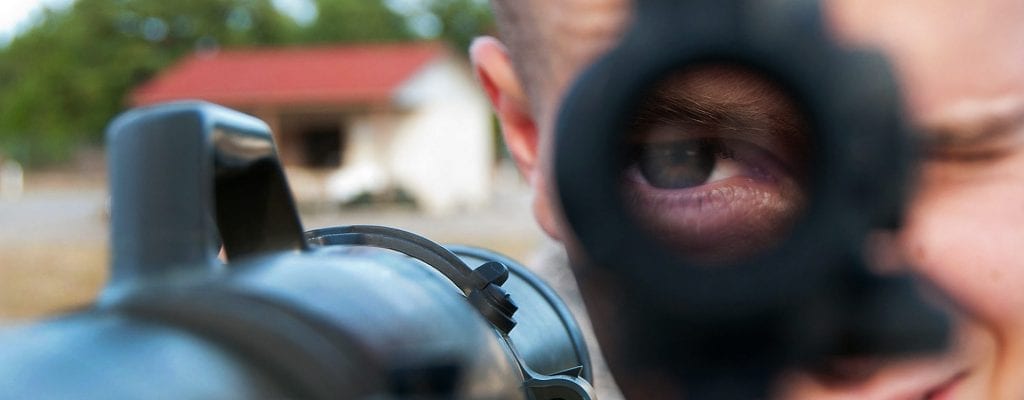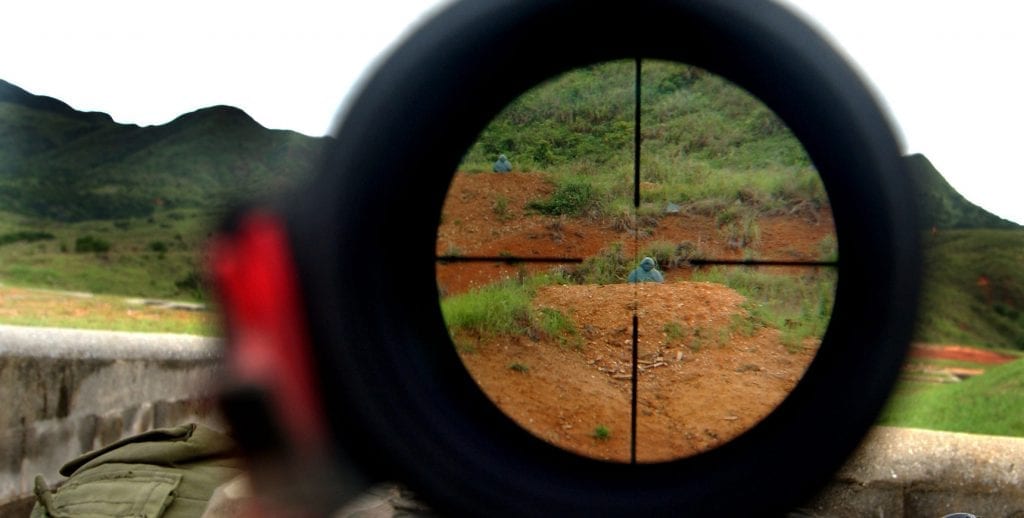So you are in the market for a rifle scope?
Whether you are a hunter, target shooter, survivalist or a weekend range regular, buying a rifle scope can often be a dangerous venture if you don’t know exactly what you are looking for. When I first bought my rifle scope, I was shocked at how much a decent scope would cost, with most quality ones being close to the price of a rifle, or more. To help you sort your way between the good to the bad, there are a few things you should know about rifle scopes.
What should you be looking for and how can you tell if the rifle scope is going to be quality or not? In such a big market with so many competing brands it’s easy to think that the cheap option might be the good option. Well sadly, that is not the case.
You have probably heard many times a worn out saying “you get what you pay for,” especially when one intends to buy a rifle scope. If you know anything about them, you will know that a lot of quality scopes can be in a similar price-range to many intro-level rifles. When first-time buyers pick up their first rifle, many underestimate the pricing of a quality scope and end up buying the cheaper version, only having to replace it later down the track (or sooner).
Low budget rifle scopes are generally cheap for the reason that they use cheaper materials and/or cheaper labor, which inevitably results in the loss of quality and lack of durability in a rifle scope. That’s also not to mention the fact that at times, with some cheap scopes, you’re not going to hit anything at all as there is no just no reliable accuracy to them.
What’s a Rifle Scope
A rifle scope simply provides magnification so you can see further and improve your accuracy. For example, when I use a good scope on my AR-10, I’m easily able to hit targets out to 400 yards.
When looking through a scope, you’ll notice some form of graphic image pattern. That’s called a reticle, which is your aiming point. I’ll cover this more in-depth later. For now, just know that a rifle scope is an optical sighting device that is equipped with a reticle to allow you to see further.
What’s the Purpose
The first step in choosing the best scope for your rifle is to ask yourself, “what exactly am I going to use the scope for?”
You could use your scope for things like:
- Hunting
- Competition
- Home Defense
- Target Shooting
You get the idea. It’s important to know this information because each scope differs from one another. After you found out your use, it’s time to understand basic scope terms, starting with…
Fixed vs. Variable Scope
When looking at a scope, usually you’ll see some numbers. For example: UTG 3-9×32 BugBuster Scope. Let’s dissect the numbers, 3-9×32.
3-9x means it’s a variable scope that allows you to change magnification for different shooting conditions. So you can magnify from 3x all the way up to 9x. You should definitely go with a variable powered scope if you intend on shooting at different distances.
However, if a scope’s magnification is 3×32, that means it’s a fixed scope. It could only work at one power (3x) — no more, no less. The benefit of using a fixed powered scope is usually they offer a clearer, brighter view and it’s more affordable.
For me personally, I prefer to go with a variable powered scope since it gives me that freedom to look through various magnifications while a fixed scope doesn’t.
Basic Reticle Types
Here are the three most popular reticles:
- Duplex Reticle – The simplest crosshair pattern. Great for hunting and target shooting.
- Mildot Reticle – Like the Duplex reticle except there are dots that help estimate the target’s distance based on size. Great for military, law enforcement and security.
- Bullet Drop Compensating (BDC) – It has hash marks towards the bottom that help you gauge where a bullet will land at x distance. Amazing for long-range shooters.
Longer Range
Have you ever watched American Sniper?
Why does the soldier (Chris Kyle) use a scope? So he can see the target more clearly, have better accuracy and a cleaner, more reliable shot. There’s no way he can use his bare eye to hit a target from the range he was at (over 100+ yards).
That’s exactly why you should mount a scope on your rifle — to extend your range. If you’re a hunter, competitive shooter or someone who shoots recreationally at the range, mounting a scope will help tackle long-range issues.
Better Accuracy
Scopes significantly improve accuracy.
How? By magnifying and clarifying the views of a target. All you have to do is look through a scope, adjust the turrets (elevation and windage), possibly adjust parallax (if your scope comes with it) and boom! Your accuracy will improve several folds.
It’s that easy. Of course, you’ll first have to sight in your rifle scope and get some practice shots in. But for the most part, most shooters that use a rifle scope will have better accuracy — especially if shooting longer-range distance shots.
How much is a good rifle scope?
For most rifle scopes, less is poor. That will mean you will have poor accuracy, reliability, and quality in your scope. The comparison for rifle scopes is very akin to that of cars. If you’re going to buy a dead cheap one, it’s going to either be a lucky star of a buy, or it is going to cause you a lot of stress and ruin your shooting experience. With a mid-range budget rifle scope, you are able to enjoy more of what you do, and then as you progress, a more advanced (and more expensive) rifle scope might be a better option.
When you are looking around online for a scope for your hunting or competition rifle, you should keep to a middle ground budget of the rifle scope market and make sure that whatever you’re considering, it includes decent craftsmanship and necessary features at prices that fit within a budget you have set.
For this guide, we recommend setting a budget of, at the very least, $200-$250 and a maximum of $600-$700. Of course, if you are more experienced with shooting, and are a regular shooter, you might want to invest a considerable amount more in a rifle scope such as the Vortex Razor or Sightron SIII which are for a much higher budget.
How does a rifle scope work?
Before we get into the specific features you should be looking for, I thought it would be a good start of this post to explain how a rifle scope actually works, so that you know the specifics of what you are buying, and why quality matters.
In the most basic explanation of a rifle scope, it serves as nothing more than a tube that holds lenses for magnification and a small reticle to indicate where your bullet would land when shot. It’s the same as a telescope, but with a target for a precise aim.
As you can see in the diagram below, a rifle scope is a little more technical than the basic description I gave above. There are a lot of working parts to it which is why many of the advanced scopes on the market are high-priced accessories.
So what are the most important parts of a rifle scope? The larger lens which sits at the front of the scope, farthest from the eye, is the objective lens. The objective lens (located in the objective assembly in the image above) transmits light to the ocular lens (the lens closest to your eye). The light passes through from the objective lens to a focal point inside the scope. The ocular lens acts as a magnification on that focal plane.
The reticle, which is more commonly known as the crosshairs, will be located either in front of, or behind, the magnifying lenses. If it is in front of the lens it is known as a first focal plane reticle. In that type of rifle scope, when you change the magnification, the crosshairs will adjust in size for the person looking through the scope. For the second focal plane reticle, the reticle crosshairs is behind the magnifying lens. In this case, from the shooter’s perspective, the reticle stays the same size, but changes in size in relation to the target as the magnification is changed.
So now that we know a little more about what we’re looking for in a good rifle scope, let’s take a look at some of the popular brands currently on the market.
What are the best rifle scope brands?
There are literally hundreds of brands of rifle scopes that I could write about here, which would no doubt make a very exhaustive post on its own. Instead, I am going to pick out a few rifle scope brands that I think are some of the best brands to accompany a good rifle.
All of these scopes are within our initial budget and are great for both first-time buyers and experienced shooters:
- Nikon MONARCH 3 German 4 Riflescope, Black, 1-4×20
- Nikon Buckmasters II 3-9×40 BDC (Image above)
- Leupold 115370 Mark AR MOD 1 Rifle
- Vortex Optics DBK-10021 Diamondback HP 4-16×42 Riflescope
- Athlon Optics , Argos BTR , Riflescope , 6-24 x 50 First Focal Plane (FFP)
- Nikon P-223 3-9×40 Mate BDC 600
- Vortex Optics Crossfire II 3-9×40 Second Focal Plane Riflescopes
- Bushnell Optics FFP Illuminated BTR-1 BDC Reticle-223 Riflescope 1-4x/24mm
- Nikon PROSTAFF 5 Mildot Riflescope, Black, 4.5-18×40
You can find more rifle scope brands here.
There are a number of specifications, designs, and materials that make these rifle scopes more effective than others, but for the most, it is because these manufacturers have been designing rifle scopes and have developed them over a number of years, making improvements based on customer feedback and professional insight. This is what you get when you pay in this range for a rifle scope.
So what are some of the specifications you should be paying attention to when looking for one of these scopes or any other rifle scope out on the market?
What should you be looking for when buying a rifle scope?
If you’re buying a new scope for your rifle, there are some specific qualities you should be looking for. The first thing is to define your needs and then decide what exactly you want from your new rifle scope. Whether you are a hunter, casual range shooter or a target shooter, you might be looking completely different features to what others may have used it for.
We have taken a look at how a rifle scope works, and some of the top rifle scope brands, so now it is time to take a look at the seven things you need to consider and look out for when buying a rifle scope.
1. Magnification
If you plan to use a scope on your hunting rifle, you should decide first about where you hunt and what you hunt. A few decades ago, a classic, fixed 4x or variable 3-9x scopes were common among many basic hunting rifles. Because the shots under 100 yards are ubiquitous for everything from hogs and deer to coyotes, these lower magnification riflescopes were perfect. Today the candidates for an “all-around” scope should be ones with lower magnifications levels too, but now with the 4:1 zoom ratio (2.5-10×) or even bigger.
If you are shooting long distances using full-scale rifles, you will need zoom ranging from at least 12x-20x. Unlike off-hand shooting with low-powered scopes, any magnification above 10x will require a supported position.
2. Construction
The body of the scope or the “main tube,” can vary in diameters of 25 mm, 30mm and 34 mm, this largely depends upon the brand and the type you are looking for. Buying a scope with larger tubes provide more space for interior components and increases the range of adjustment, which is vital for long-distance targeting. Besides, the bigger housing demands special mounting rings that can be pricier and more limited in selection. If you’re going to spend a lot on a scope, you shouldn’t have to spend much over $50 for the base mount.
As a typical feature, all modern scopes are nitrogen or argon-purged to prevent fogging and they are waterproof and shockproof as well. The Nikon Buckmaster (image above) like many other quality rifle scopes, is ntrogen-purged to make it completely fog and waterproof.
3. Objective Lens
To put it to you simply:
Objective lens is the lens at the end of the scope responsible for transmitting light. Here the situation is pretty straightforward, the larger the objective lens is, the more light can enter the scope allowing better performance in low light conditions. You can find how much objective lens a scope has by looking at the second number behind the x. For example, 3-9×32 means it has a 32mm objective lens (OL). Also, the bigger the objective lens is, the brighter and clearer your image will look. Does that mean that you should get a scope that has the largest objective lens? Not at all. Matter of fact, having too much objective lens will make your scope heavier and require taller rings.
Objective lens sizes are ranging from 20 mm to 72 mm, but you should note that optics with a 50-mm glass bell or larger requires the riflescope be mounted higher. This can have an effect on scope-to-eye alignment and consistency of cheek weld. Anyway, you should always try to mount a riflescope as low as possible without the objective bell touching the barrel.
To ensure maximum brightness, the lenses should be protected with some hydrophobic or hydrophilic lens coating, and have multiple layers on all air to glass surfaces. That highest coating level is known as fully multi-coated glasses.
4. Eye-relief
Eye relief is important if you don’t want to get a bruised eye after firing your gun. Let me explain. Do you know how whenever you pull the scope up to your eye level to see through it, there is some distance between the ocular lens and your eye? That’s eye relief.
While the most common eye relief is around four inches, less-quality scopes boast only 3-3,5 inches, and this is very short eye distance for the higher recoiling rifles. As a word of caution, the higher eye-relief is must for the owners of powerful-rifles to avoid scope-eye as seen above (I’m sure you have seen the horror stories of inexperienced users with black eyes). There is a specific niche of firearms requesting long eye relief scopes. These scopes are most commonly found on scout rifles, certain surplus rifles and hunting revolvers with eye relief ranging from 6-16 inches.
5. Reticle and Focal Plane
For a first time riflescope buyer, it is recommended to select a standard “Duplex” or a German No. 4 reticle. While these type of reticles are sufficient for most hunting arms, ranges and conditions, the long-range competitors and varmint shooters may demand a finer crosshair. For long-range target and tactical shooting, you have a choice of more complex to understand “Christmas tree” types of reticles, yet really popular because of their impressive tactical features.
There is another important decision of choosing between the scopes with a reticle positioned in the first or second focal plane. The focal plane refers to the position of your reticle within the scope. The reticle located in the first focal plane (FFP) means that the reticle maintains the same perspective with the target size throughout the magnification range and it is preferred by the long-range shooters. With a First Focal Plane (FFP) reticle, the reticle size adjusts as you change magnifications.
For example, if your magnification is at 3x and you zoom it in at 5x, then the reticle will enlarge. Use an FFP reticle if you specialize in long-range shooting. If it is placed in the second focal plane (SFP), it means that when you increase the power zoom, the target appears larger but the reticle will stay the same size. The benefit of using an SFP is that it gives you a clear picture through all powers. For the most part, you’re better off with an SFP reticle. However, if you intend on using your scope for long-range shooting, then go for an FFP reticle.
You can choose an illuminated reticle as it can help you improve sighting in low-light conditions, mainly when hunting during dawn and dusk.
6. Parallax
The parallax is not present at all in most low-magnification scopes, but it occurs in high-power scopes utilized over long distances when your line of sight is not exactly lined up. Parallax is an optical illusion that increases with magnification, giving you a larger margin of error at higher powers and it must be corrected. High power riflescopes usually feature an adjustment ring located on the objective bell as more expensive sports side-mount turret.
7. Turrets and Adjustments
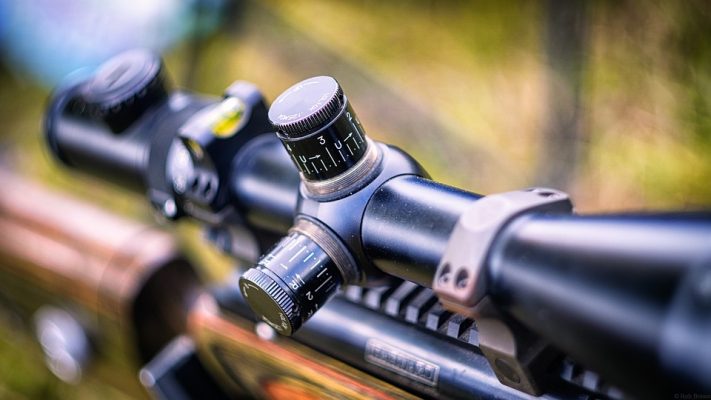
In addition, lots of companies make low-profile ballistic knobs that are often capped to prevent any accidental adjustments. On the other side, there are target knobs with open style turrets intended for the precise adjustments and featured by their height and often-small adjustment scales.
The turrets are also available with two key adjustment systems with the first expressed in MOA (Minute Of Angle) and corresponding to 1 inch (2.5 cm) when shooting at 100 yards. Another is a bit complicated and expressed in MRAD, where 1 MRAD is approximately 3.6 inches (9.1 cm) at 100 yards. While the MOA is the most common for a variety of shooters, the MRAD system is favored by long-range shooters.
What Scope should I buy?
It honestly depends on what you use it for. If you shoot within 100 yards, stalk small game or homestead defense, I recommend using a scope that has a magnification of 1x – 4x. If you shoot targets up to 200 yards, stalk large game or hunt in closed landscapes, then I recommend using 5x – 8x magnification scope.
Lastly, if you are a long-range shooter (200+ yards), you’re definitely going to need a scope specifically for long-range — usually above 9x magnification. Still unsure? Then come stop by my little house on the internet: Scopes Field. This is where I hand-test and review scopes for almost every major rifle and caliber.
Over to you…
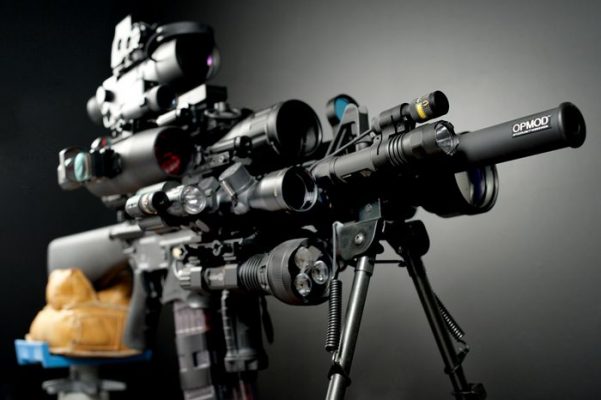
Making a guideline for choosing an appropriate scope and narrowing the field to the “right” one can be a daunting task. You can buy rifle scopes ranging from cheap $50 imports all the way up to $2,000+ high-end scopes, but the golden rule to be followed is to spend at least half as much on the optics as you have on the rifle itself.
Some other articles you might enjoy on rifles are:

